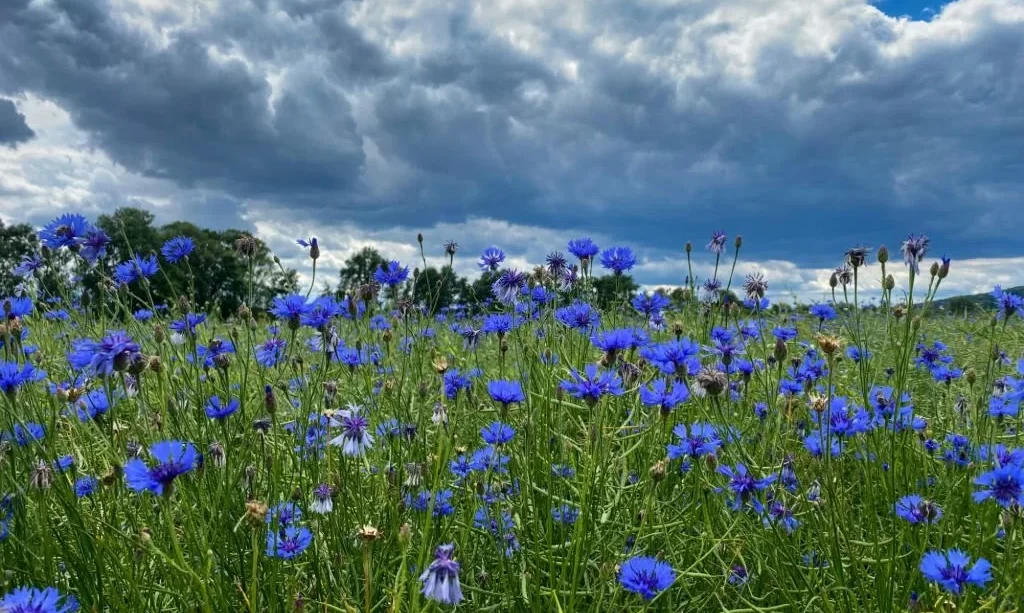In the colorful tapestry of garden blooms, bachelor buttons, also known as cornflowers, stand out as charming, vibrant additions. These delicate flowers have captured the hearts of garden enthusiasts for generations with their striking blue, purple, pink, and white petals. However, beyond their aesthetic appeal, bachelor buttons have sparked curiosity about their edibility and culinary potential. In this article, we’ll delve into the world of bachelor buttons to explore whether these garden gems can find a place on our plates. Join us on this culinary adventure as we uncover the historical uses and potential culinary delights of bachelor buttons.
- Non-GMO Bulk Bulk Cornflower / Bachelor Button Seeds – “Tall Mix” Centaurea cyanus
- Fortified with Mycorrhizae, Beneficial Bacteria & Trichoderma for Easy, Superior Growing!
- 100% Pure Seed, No Fillers.Non GMO, Heirloom, Open Pollinated.
- Annual; Grows 28-36 Inches Classic Wildflower; Symbolic of Young Love Easy to Grow; Adaptable to Sun & Shade
- 250-500 Sq Ft Coverage
Bachelor Buttons in the Garden
Before we explore their culinary possibilities, let’s take a moment to appreciate bachelor buttons in their natural habitat—the garden. These annual or perennial plants are renowned for their easy cultivation. They boast slender stems adorned with fern-like leaves and, of course, the signature radiant blooms. Bachelor buttons come in various shades, but the vibrant blue variety is perhaps the most famous. Gardeners love them for their ability to attract pollinators like bees and butterflies, adding life and beauty to any garden. As ornamental flowers, they have a rich history of adorning landscapes and bouquets. But could their role extend beyond mere decoration?
Historical Culinary Use
The story of bachelor buttons as a culinary ingredient dates back centuries. In the past, these lovely blooms found their way into kitchens and teacups. Bachelor buttons were used to infuse herbal teas, adding a delicate floral note to the brew. Additionally, their petals were employed as edible garnishes to enhance the visual appeal of dishes. They often adorned salads and desserts, lending a touch of color and elegance to the culinary creations of yesteryear. As we explore the historical culinary use of bachelor buttons, we’ll uncover whether these blossoms can still grace our modern dining tables.
Edibility of Bachelor Buttons
Now, let’s address the burning question: Are bachelor buttons truly edible? The answer is a bit nuanced. While bachelor buttons, or cornflowers, are generally considered safe to eat, it’s essential to note that not all varieties are created equal in the culinary sense. Some varieties have petals that are tastier and safer for consumption, while others may not be suitable due to potential bitterness or pesticide exposure. It’s crucial to ensure that the bachelor buttons you intend to eat have been grown without harmful chemicals.
Edible Parts and Preparation
When it comes to bachelor buttons, the edible parts are primarily the petals. The vibrant petals can add a mild, slightly sweet flavor to your dishes. To prepare bachelor buttons for consumption, gently pluck the petals from the base of the flower. Avoid using the stems and leaves, as they tend to be more bitter and are less commonly consumed.
Once you’ve gathered the petals, you can get creative in the kitchen. Bachelor buttons make beautiful and edible garnishes for salads, desserts, and even cocktails. They can add a burst of color and a subtle floral note to your culinary creations. Just remember to use them sparingly, as their flavor can be delicate, and a little goes a long way. When using bachelor buttons in recipes, be sure they are free from any chemicals or pesticides, as these can be harmful when ingested.
So, while bachelor buttons do have an edible side, it’s essential to be selective about the variety you choose and to use them mindfully in your culinary adventures. With proper care and attention, you can add a touch of floral elegance to your dishes with these charming garden blooms.
Culinary Uses
Bachelor buttons, with their vibrant and delicate petals, can be a delightful addition to various culinary creations. Their mild, slightly sweet flavor makes them versatile in the kitchen. Here are some culinary uses for these charming blooms:
- Salads: Bachelor buttons can elevate your salads both visually and in terms of flavor. Toss a few petals into a green salad for a pop of color and a subtle floral note.
- Desserts: Sprinkle bachelor button petals over cakes, cupcakes, or pastries to give your sweet treats an elegant touch. They pair beautifully with desserts like ice cream, sorbet, and fruit salads.
- Cocktails: Create visually appealing and aromatic cocktails by adding bachelor button petals to your drinks. They work well in beverages like gin and tonic or floral-infused cocktails.
- Teas: As in historical times, bachelor buttons can be used to infuse herbal teas, imparting a gentle floral flavor and a lovely hue to your brew.
Remember, a little goes a long way when using bachelor buttons in culinary applications. Their delicate flavor can be easily overwhelmed, so use them sparingly for the best results.
Cautions and Considerations
While bachelor buttons are generally safe to eat, there are a few cautions and considerations to keep in mind.
- Pesticides: Ensure that the bachelor buttons you plan to consume are grown without the use of pesticides or chemicals, as these can be harmful when ingested.
- Allergies: Some individuals may have allergies to certain edible flowers, including bachelor buttons. If you have allergies to plants in the Asteraceae family (such as marigolds or daisies), it’s advisable to exercise caution when trying bachelor buttons for the first time.
- Moderation: Use bachelor buttons in moderation. Their flavor is subtle, and too many petals can overpower a dish or beverage.
Final Thoughts
In conclusion, bachelor buttons, also known as cornflowers, offer a delightful opportunity to incorporate a touch of floral elegance into your culinary endeavors. Their edible petals can add color, flavor, and visual appeal to salads, desserts, cocktails, and teas. However, it’s essential to exercise caution by ensuring that the flowers are pesticide-free and using them sparingly to appreciate their delicate flavor. Whether you’re a culinary explorer seeking new flavors or a gardener looking to make the most of your blooms, bachelor buttons provide a charming and edible option for your creative kitchen adventures. Enjoy the culinary journey with these delightful garden gems!




